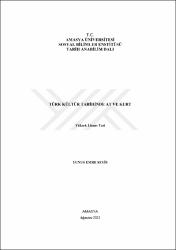| dc.contributor.advisor | Polat, Kemal | |
| dc.contributor.author | Seyis, Yunus Emre | |
| dc.date.accessioned | 2022-03-09T14:56:25Z | |
| dc.date.available | 2022-03-09T14:56:25Z | |
| dc.date.issued | 2021 | |
| dc.identifier.uri | https://tez.yok.gov.tr/UlusalTezMerkezi/TezGoster?key=tqUiYt63sTQLTpozMJ92QmlABNd5DJJ5XbhCP8WNfep3VSSj4Vm0EvhFoqi0By-W | |
| dc.identifier.uri | https://hdl.handle.net/20.500.12450/1956 | |
| dc.description.abstract | Bu çalışma, özellikle Genel Türk Tarihinden temel alınarak Türklerin yaşayışlarında, inançlarında ve kültürlerinde hayvanların etkisi ve üslubunu araştırmaktır. Bu bağlamda mevcut dönemi anlatan destan, efsane gibi edebi anlatılar olmak üzere bilgi, belge ve dokümanlardan yararlanmanın yanı sıra yine dönemi yansıtan tarihi eserler, kalıntılar ve kabartmalarla döneme ışık tutmaktır. Böylelikle günümüz ve eski çağlar arasındaki ilişki daha objektif bir perspektifle incelenerek bu araştırmanın tarih alan yazınına katkı sağlaması beklenmektedir. Eski Türk kültürünün çeşitli deri, taş ve diğer yapılara işlediği bu hayvan şekillerinin içerdiği hayvanları ve bu hayvanların ifade ettikleri anlamları bulmak araştırmamızın öncelikli amaçlarından birisi olup bu anlamların günümüz tarihine kadar olan süreçte nasıl yorumlandığını incelemektir. Bu hedefler doğrultusunda amaçlı örneklemler kapsamında seçilen kurt ve at gibi en çok adı geçen hayvanlar çeşitli yönlerle incelenmiştir. Araştırma analizi yapılırken olumlu ve olumsuz anlamları birlikte verilmeye çalışılmış, böylelikle araştırmaya objektif bir bakış açısı kazandırılmaya çalışılmıştır. | en_US |
| dc.description.abstract | This study is to investigate the animals influence and style in the lives, beliefs and cultures of the Turks, especially based on the General Turkish History. In this context, it is to shed light on the period with historical artifacts, ruins and reliefs that reflect the period, as well as making use of information, documents and documents, including literary narratives such as epics and legends. Thus, it is expected that this research will contribute to the history literature by examining the relationship between the present and the ancient ages with a more objective perspective. One of the primary aims of our research is to find the animals contained in these animal shapes, which ancient Turkish culture has embroidered on various leather, stone and other structures, and the meanings these animals express, and to examine how these meanings have been interpreted in the process until today. For these purposes, the most mentioned animals such as wolves and horses, which were selected within the scope of purposeful samples, were examined from various aspects. While analyzing the research, positive and negative meanings were tried to be given together, so that an objective perspective was gained to the research. | en_US |
| dc.language.iso | tur | en_US |
| dc.publisher | Amasya Üniversitesi | en_US |
| dc.rights | info:eu-repo/semantics/openAccess | en_US |
| dc.subject | Tarih | en_US |
| dc.subject | History | en_US |
| dc.subject | At kültürü | en_US |
| dc.subject | Horse culture | en_US |
| dc.subject | Bozkurt | en_US |
| dc.subject | Graywolf | en_US |
| dc.subject | Milli kültür | en_US |
| dc.subject | National culture | en_US |
| dc.subject | İnsan-hayvan etkileşimi | en_US |
| dc.subject | Human-animal interaction Onaylandı | en_US |
| dc.title | Türk kültür tarihinde at ve kurt | en_US |
| dc.title.alternative | Horse and wolf in Turkish culture history | en_US |
| dc.type | masterThesis | en_US |
| dc.department | Enstitüler, Sosyal Bilimler Enstitüsü, Tarih Ana Bilim Dalı | en_US |
| dc.identifier.startpage | 1 | en_US |
| dc.identifier.endpage | 87 | en_US |
| dc.relation.publicationcategory | Tez | en_US |
| dc.identifier.yoktezid | 699373 | en_US |
| dc.institutionauthor | Seyis, Yunus Emre | |


















